The History of Golf Courses in Parks

By the time Van Cortlandt Golf Course opened on July 6, 1895, the popularity of the sport had been growing steadily for several decades. The course came about when a group of local businessmen in Riverdale had tried unsuccessfully to find private lands within the City large enough to accommodate a new grand-scale, fully appointed golf course.
Quick Facts
Van Cortlandt Park Golf Course
- In addition to being the first public course in the country, Van Cortlandt Golf Course hosted the country's first public golf tournament in 1896.
- Visitors have included Babe Ruth, Willie Mays, Jackie Robinson, and Joe Louis. The Three Stooges also made Van Cortlandt their preferred golf course.
Breaking New Ground in the Bronx
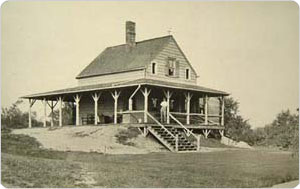
The Riverdale group — including T. McClure Peters, B.W. "Gus" Schwab, Moses T. "Percy" Pyne, and Cleveland H. Dodge — petitioned James A. Roosevelt, a member of the Board of Parks Commissioners, to contribute to the cost of building a golf course in Van Cortlandt Park. The group developed the course, setting up bunkers and greens on a nine–hole course. Although Roosevelt agreed that a course could be useful to attract people to use the new park, the city could not allow a municipal asset to be in private hands. In the end, the "Mosholu Golf Club," as the Riverdale group called itself, had exclusive use of the course for two afternoons a week, but that was all. The course at Van Cortlandt Park, now open to the general public, represented the first municipal golf course in the U.S.
At a time when most American golf courses were private — and held the right to control who could play — the Van Cortlandt Park course broke new ground. And as the game of golf opened up to the public, its popularity soared. The average New York resident could tee–up alongside celebrities, and new golfers organized clubs to further their enjoyment of the game.
The Mosholu Golf Club founders took advantage of Van Cortlandt's wildly sprawling grounds. Unlike the City's more manicured parks, Van Cortlandt made one forget the teeming urban landscape outside its borders. To golf enthusiasts, the fields, tall grasses, and colorful wildflowers of Van Cortlandt furnished the perfect spot for the golf links, which quickly earned the nickname "The Meadows."
T. McClure Peters constructed the nine–hole course north of Van Cortlandt Lake for a cost of $624.80. The original layout spread over today's 1st, 2nd, 3rd, 6th, 7th, 12th, 13th and 14th holes. Playing through the 2,561–yard course was relatively easy for the first eight holes, each less than 200 yards. Then, golfers confronted the ninth hole, with a 700-yard fairway that crossed two stonewalls and two small brooks. The ninth hole was among the longest and most challenging hole ever created in the United States.
Quick Facts
Van Cortlandt Park Golf Course
- The house's locker rooms, dating to 1902, have retained their original wooden lockers, which were featured in a scene from the Oliver Stone film Wall Street (1987).
- In the 1940s and 1950s, Bendelow's course had to make way for the Major Deegan Expressway and the Mosholu Parkway Extension. Architect William Follet Mitchell rearranged fairways, eliminated two hillside holes, and added four new holes west of the Putnam Railroad line.
Establishing Order on the Green
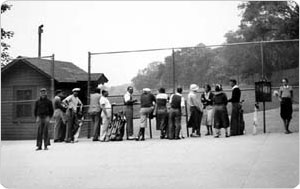
In its first year, there were no set rules at the Van Cortlandt Golf Course, and it quickly became overcrowded. Unheard of in this day and age, the only charge was for a caddy, and those who did not use one paid nothing for the privilege of golfing at Van Cortlandt. (During this era, golfers at Boston's Franklin Park paid a 25–cent fee.) Local newspapers blasted the poor playing conditions, the unmanageable crowds, and a general lack of golf etiquette.
As a result, the City hired Scottish–born Golf Architect Thomas Bendelow in 1899 to manage the course and oversee its expansion from a 55–acre, 9–hole course to a 120–acre, 18–hole course. Bendelow — described by some as the "Johnny Appleseed of American Golf" — was a prolific early golf course designer, and designed some 700 courses in his lifetime. Contemporary observers noted that golfers came from as far as 40 miles away to enjoy the new course, aided by a train station near the 18th hole.
Putting in Pelham Bay Park
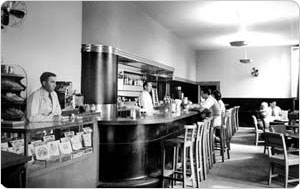
Another early public golf course was the Pell Golf Course was, opened in 1901. The bucolic countryside of Pelham Bay Park, established in 1888, provided the new links with a scenic, natural backdrop. The pastures upon which the Pell course was laid out had once been productive farmland. The estate had been known as "Greystones," and was owned by the De Lancey family who were descendants of John Hunter (for whom Hunter Island is named). In 1911, the course was upgraded to a full 18–hole course.
Quick Facts
Pelham/Split Rock Golf Course
- The 1900 Parks Annual Report notes that when the original nine-hole Pell Golf Course was built, Parks removed trees and stone walls that demarcated the estates that previously occupied the land. The De Lancey family were descendants of John Hunter (for whom Hunter Island is named); their second empire-style mansion was leased by Parks from 1898 until 1918 and operated as a popular roadhouse, the Hunter Island Inn, also serving as the golf clubhouse until it was demolished.
- Course designed by John Van Kleek.
Also opened in 1901 was the nine–hole (expanded to 18 holes by 1905), 110–acre, Forest Park Golf Links, another successful course designed under Parks' oversight. Located at the park's western edge, its golf house featured 400 lockers for crowds, a development perhaps informed by the chaotic conditions at Van Cortlandt Park, which were described as dilapidated from overuse just a few years after its 1899 reopening.
The delicate nature of establishing a course in an urban area was evident as early as 1916, when several holes at Forest Park had to be moved to "eliminate friction between residents of this section and the golf players."
Quick Facts
Forest Park Golf Course
- Opened in 1901 as a nine-hole course.
The Golf Boom
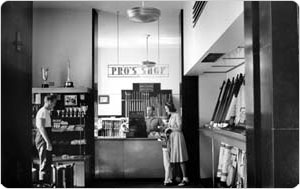
Another course at Van Cortlandt Park, the Mosholu golf course opened in 1914. (In 2004, the City began construction on a filtration plant under a portion of Mosholu golf course for its water supply; as part of the agreement, more than $200 million will be spent on improvements to over 70 Bronx parks.) The general public took to these facilities quickly. In 1899, 2,000 golfers played the Van Cortlandt course. Eventually, it was common for up to 700 golfers to complete the course on a typical Saturday, Sunday or holiday. And by 1920, there were an estimated 5,000 golfers per week teeing off at Van Cortlandt. Because both Pell and Van Cortlandt golf links were being used much more extensively, Parks instituted a reservation system (initiated by Thomas Bendelow) on weekends and holidays.
Quick Facts
South Shore Golf Course
- Until 1984, Parks managed the course and the adjoining restaurant. At that time, the American Golf Corporation took over the management of the course, the 'grill room' snack bar, and the pro shop. In 1989, the restaurant came into the hands of Laurence Toto, who restored the existing 19th century Dutch Colonial revival building.
Golf experienced a boom in the 1920s, and several more facilities opened in the city. Land from Marine Cemetery, a nineteenth–century burial site for the Marine Hospital Quarantine in Tompkinsville was added to Staten Island's Silver Lake Park in 1924, and in 1929, a golf course opened on the site. (Today it is thought that perhaps several thousand immigrants, including many Irish escaping Ireland's Potato Famine, who died from contagious diseases after landing in the United States, are buried under the 18th fairway of the golf course.) The golf course at Silver Lake Park helped the park become a recreational hub for the developing borough.
Clearview Park and Golf Course in Queens was founded in 1925 as the Clearview Golf and Yacht Club, an exclusive retreat for notable New Yorkers such as the renowned New York State Governor Alfred E. Smith. The South Shore Golf Course — which was taken over by Parks in the 1960s — was founded in 1930 as the Mayflower Country Club.
Quick Facts
Clearview Golf Course
- Originally named the Clearview Golf and Yacht Club, the establishment served as an exclusive retreat for New Yorkers. One notable member was the renowned New York State Governor Alfred E. Smith (1873-1944).
- Landscape architect Willie Tucker designed the golf course, which lies on gently rolling terrain.
- Beginning in 1999, Clearview Golf Course received a sophisticated irrigation system designed to combat erosion and improve course conditions. The $9.8 million dollar project also provided irrigation for the Douglaston, Forest Park, and Kissena Park golf courses. The newly installed irrigation systems use in-ground sprinkler heads fed by underground pipes. Ponds, which rely almost exclusively on rainwater, were built in addition to wells and brick pump houses.
Moses Continues Course Creation
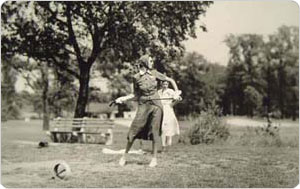
Golfing stayed popular, even during the Depression, and the demand for golf courses increased steadily. Taking advantage of the economic downturn, on June 25, 1931, the City of New York purchased the Clearview Golf and Yacht Club for $940,000, about half the asking price. Under the tenure of Parks Commissioner Robert Moses (1934–60), New York City's recreational facilities saw great changes. With federal funding provided by the Works Progress Administration, Moses created a variety of new public facilities and expanded others throughout the city. Between 1935 and 1940, Parks redesigned the entire course and built new club facilities. The Kissena Golf Course opened in 1935. The course in Pelham Bay was renovated in 1936 as part of a WPA–funded project, and the adjacent Split Rock course was opened then. Golf legend Bobby Jones visited the courses in 1936, calling Split Rock "worth the visit," and commending the courses' architects. The stately Pelham Club House also opened during this era; the plantation'style building is currently undergoing renovations to return it to its former splendor.
Quick Facts
LaTourette Golf Course
- LaTourette Park, like much of the surrounding area, was once the farm property of David (1786–1864) and Ann (1794–1862) LaTourette. The LaTourettes first established their farm in 1830. Over time, the farm became one of the top producing family–run farms on Staten Island, renowned for its superb produce.
- In 1928, the LaTourette family sold their farm to the City of New York. The site was transferred to Parks in 1955 and was designated a New York City Landmark in 1973. Although the original farmhouse was demolished, the LaTourette's 1870 mansion is now used as a club house for the park's golf course. In 1982, the mansion was added to the National Register of Historic Places. In 2001, a fire damaged the house, but the tragedy provided an opportunity to return the building to its original state.
Private Courses Arrive and Depart
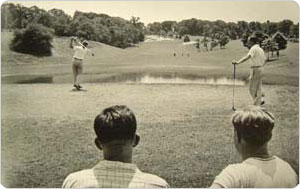
New York City eventually had several private golf courses (the Richmond County Country Club in Staten Island is the last remaining private course; Parks Commissioner Newbold Morris wanted to purchase it in the 1960s). Queens courses in Bayside and even Jackson Heights are no longer extant and a six–hole course in Sunset Park, Brooklyn existed at the turn of the century. Other private courses reverted to the city. South Shore Golf Course in Staten Island was acquired by the City in 1966. The Dyker Meadow Golf Club became the course at Dyker Beach Park. The North Hills Golf Course in Douglaston, Queens was purchased by the city in 1962, and opened as the Douglaston Park Golf Course in 1963.
Quick Facts
Silver Lake Golf Course
- Land from Marine Cemetery, a nineteenth–century burial site for the Marine Hospital Quarantine in Tompkinsville, was added to the park in 1924. In 1928, the land was converted to a golf course, and in 1994 researchers discovered documentation linking the site to its past use as a cemetery.
- Today, it is thought that perhaps several thousand immigrants, including many Irish escaping Ireland's Potato Famine, who died from contagious diseases after landing in the United States are buried under the 18th fairway of the golf course.
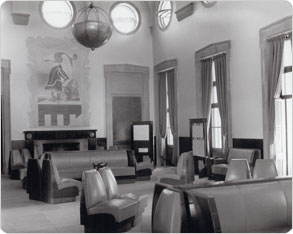
Parks also features several driving ranges — including one on Randall's Island as well as a "pitch and putt" course at Flushing Meadows Corona Park. A pitch and putt course is designed so that golfers only have to use two clubs. Commissioner Moses opened a pitch and putt course at Jacob Riis Park, as well (the site has since been transferred to the federal government).
Parks hosted a series of tournaments at Van Cortlandt Park in 1974, when over 700,000 rounds of golf were played at the course. The John Muir Benefit Golf Tournament began in 1997 and its proceeds go towards the continued care of Van Cortlandt Park. In the 1980s under Mayor Edward I. Koch, the City of New York began to license management of its 13 golf courses to private contractors. Today, American Golf Corporation, which operates over 300 recreational facilities nationwide, runs Parks golf courses.
Quick Facts
Dyker Beach Golf Course
- First–in–the–nation, free and comprehensive golf center exclusively for youth is located at Dyker Beach.
Related Video
City Parks Foundation Golf Lessons
Related Information
City Parks Golf Golf Courses and Driving Ranges BeFitNYC: Search for fitness opportunities based on interest, age, and location